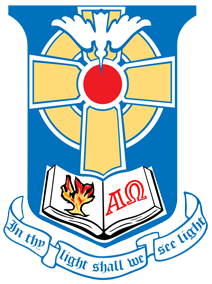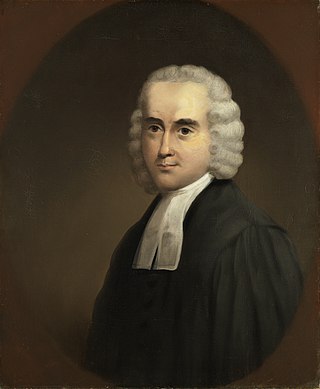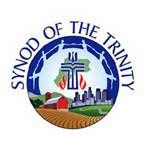
The Presbyterian Church (USA), abbreviated PCUSA, is a mainline Protestant denomination in the United States. It is the largest Presbyterian denomination in the country, known for its liberal stance on doctrine and its ordaining of women and members of the LGBT community as elders and ministers. The Presbyterian Church (USA) was established with the 1983 merger of the Presbyterian Church in the United States, whose churches were located in the Southern and border states, with the United Presbyterian Church in the United States of America, whose congregations could be found in every state.

The Cumberland Presbyterian Church is a Presbyterian denomination spawned by the Second Great Awakening. In 2019, it had 65,087 members and 673 congregations, of which 51 were located outside of the United States. The word Cumberland comes from the Cumberland River valley where the church was founded.

The Associate Reformed Presbyterian Church (ARPC) is a theologically conservative denomination in North America. The ARPC was formed by the merger of the Associate Presbytery (seceder) with the Reformed Presbytery (covenanter) in 1782. It is one of the oldest conservative denominations in the United States.

Gilbert Tennent was a Presbyterian revivalist minister in Colonial America. Born into a Scotch-Irish family in County Armagh, Ireland, he migrated to America with his parents, studied theology, and along with Jonathan Edwards and George Whitefield, became one of the leaders of the evangelical revival known as the First Great Awakening. His most famous sermon, On the Danger of an Unconverted Ministry, also known as the "Nottingham Sermon," compared "Old Side" ministers to the biblical Pharisees of the Gospels, triggering a schism in the Presbyterian Church which lasted for 17 years. A prolific writer, Tennent would later work towards reunification of the two synods involved.

The Presbyterian Church in the United States of America (PCUSA) was a Presbyterian denomination existing from 1789 to 1958. In that year, the PCUSA merged with the United Presbyterian Church of North America. The new church was named the United Presbyterian Church in the United States of America. It was a predecessor to the contemporary Presbyterian Church (USA).

The Reformed Presbyterian Church General Assembly (RPCGA) is a Presbyterian church body and conservative denomination in the United States established in 1991. The RPCGA was founded by members of the Reformed Presbyterian Church in the United States.

Jonathan Dickinson was a Congregational, later Presbyterian, minister, a leader in the Great Awakening of the 1730s and 1740s, and a co-founder and first president of the College of New Jersey, which later became Princeton University.

The Log College, founded in 1727, was the first theological seminary serving Presbyterians in North America, and was located in what is now Warminster, Pennsylvania. It was founded by William Tennent and operated from 1727 until Tennent's death in 1746, and it graduated proponents on the New Side of the significant Old Side–New Side Controversy that divided presbyterianism in colonial America at the time. The Log College was, as a physical structure, very plain, according to George Whitefield's journal; it was a private institution that had no charter. At that time, ministers could not get ordained unless they had graduated from Harvard, Yale, or a college in England. Thus, an important purpose in its founding was to support the spread of New Light Christianity by enabling proponents to become ordained. In sources dated through the early 20th century, it was referred to as a remarkable institution, with graduates including Samuel Finley, John Redman, and John Rowland. Though the number of eventual graduates is unknown, many would play important roles in the Old Side–New Side Controversy, and Log College alumni Samuel Blair, Samuel Finley, and William Tennent, Jr. would become trustees of a newly formed College of New Jersey, which would be renamed Princeton University in 1896.
The following is a list of synods and presbyteries that composed the former United Presbyterian Church in the United States of America on December 31, 1968. The UPCUSA was the largest body, often erroneously referred to as "Northern," of Presbyterianism in the U.S., prior to its 1983 merger with the Presbyterian Church in the United States, whose churches were located entirely within the Southern and border states.
Washington Presbytery, of the Presbyterian Church (USA) is the association of PCUSA churches in Washington and Greene counties in Pennsylvania.

David Steele, Sr. was a Reformed Presbyterian or Covenanter minister.

The Old School–New School controversy was a schism of the Presbyterian Church in the United States of America that took place in 1837 and lasted for over 20 years. The Old School, led by Charles Hodge of Princeton Theological Seminary, was more conservative theologically and did not support the revival movement. It called for traditional Calvinist orthodoxy as outlined in the Westminster standards.
Synod of the Northeast is an upper judicatory of the Presbyterian Church (USA) based in East Syracuse, New York. The synod oversees 19 presbyteries in six New England states, two of the three Mid-Atlantic States, plus a non-geographical Korean Presbytery.

The Reformed Presbyterian Church of North America (RPCNA) is a Presbyterian church with congregations and missions throughout the United States, Japan, and Chile. Its beliefs—held in common with other members of the Reformed Presbyterian Global Alliance—place it in the conservative wing of the Reformed family of Protestant churches. Below the Bible—which is held as divinely inspired and without error—the church is committed to several "subordinate standards," together considered with its constitution: the Westminster Confession of Faith and Larger and Shorter Catechisms, along with its Testimony, Directory for Church Government, the Book of Discipline, and Directory for Worship.
Synod of the Mid-Atlantic is an upper judicatory of the Presbyterian Church (USA) based in Richmond, Virginia. The synod oversees fourteen presbyteries in DC and five Mid-Atlantic states.
Robert Adam Holliday Lusk was a Reformed Presbyterian or Covenanter minister of the strictest sort, in a century which, according to Presbyterian historian Robert E. Thompson, was marked by increasing relaxation into less stringent manifestations of doctrine and practice amongst all branches of Presbyterianism. His career crossed paths with many prominent ministers and he was involved in numerous ecclesiastical courts at pivotal moments in the history of the Reformed Presbyterian Church. Amongst Reformed Presbyterians, he was an "Old Light," and amongst "Old Lights," he would lay claim to be an "Original Covenanter." He was descended from a long line of Scotch-Irish, and the Lusks had fled from Scotland to Ireland, escaping religious persecution; many of them settled in America prior to the American Revolutionary War.

The Presbytery of Redstone is a Presbytery of the Presbyterian Church (U.S.A.) governing congregations in Westmoreland, Fayette, Somerset, and Cambria Counties in Western Pennsylvania. Its headquarters are located in Greensburg, Pennsylvania. It governs 67 congregations and 8,249 total congregants (2022).

Presbyterianism has had a presence in the United States since colonial times and has exerted an important influence over broader American religion and culture.
The Adopting Act of 1729 was an act of the Synod of Philadelphia that made the Westminster Standards, particularly the Westminster Confession of Faith, the official confessional statements for Presbyterian churches in colonial America. Presbyterian ministers were required to believe or "subscribe" to the "essential and necessary" parts of the standards, but defining what was essential and necessary was left to individual presbyteries to determine.














